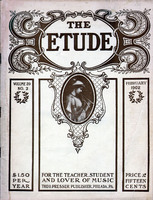There appeared in these columns, some time ago, an article on the manufacture of strings which seems to have given some readers a desire to learn something in connection with the kinds of strings one should use, how to select good strings, etc.
The Italian strings are unquestionably the best for quality, though German strings are very popular, owing to their great durability. Of the Italian strings, the Roman and Padua have always been in favor, and, of these two, the latter are by many given the preference. The Padua strings, as a rule, wear better than the Roman, but I have always preferred the Roman strings, particularly in cold weather.
Every player should be provided with a string-gauge, for without one it is quite impossible to select strings of the requisite thickness. Amateurs, and even professionals, often choose thin strings, believing that these enable them to produce a better and more brilliant tone. This, of course, is a serious mistake, as the diameter of a string should always be in accordance with the principles which determine the relations between the strings and the body of the violin.
Mr. Allen has this to say in connection with violin strings:
“When you have found a diameter of strings which suits your fiddle, keep to it, and do not experiment with new thicknesses, for it is as deleterious to change one’s style of strings as to be constantly changing the position of the sound-post. The strings must be in proper relative proportion with one another; I mean, you must not use a thick E, a thin A, or a medium D. The strings must be relatively thick, thin, or medium.
“A string, as seen in the coil or bundle at a shop, ought to be transparent, without spots or blemishes throughout its entire length. It should be pliant and elastic, returning to its former shape (like a watch-spring) without breaking, when pressed or pulled out. It should not be too white, for this betokens improper materials or excessive bleaching, both of which render a string brittle and false. A good string must not loose its transparency and become cloudy and yellow when bent.”



